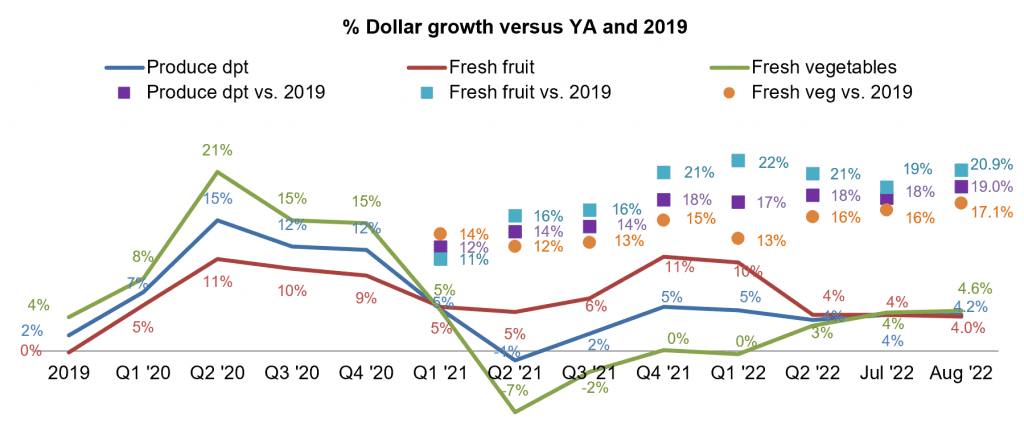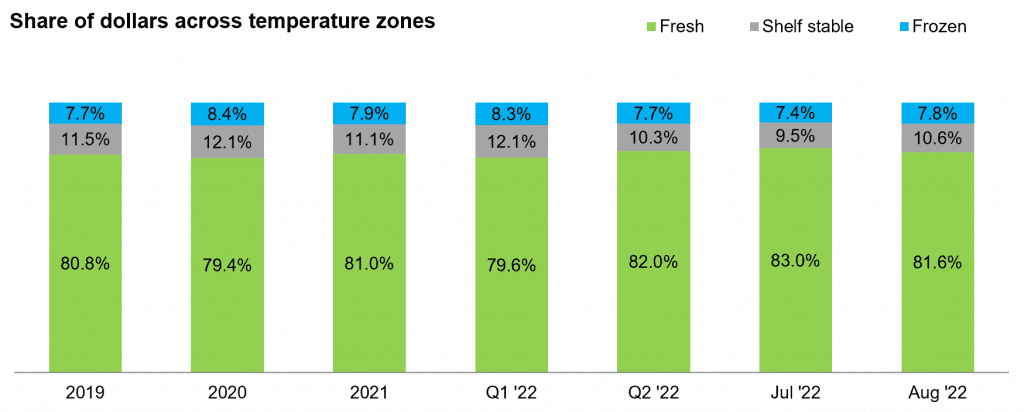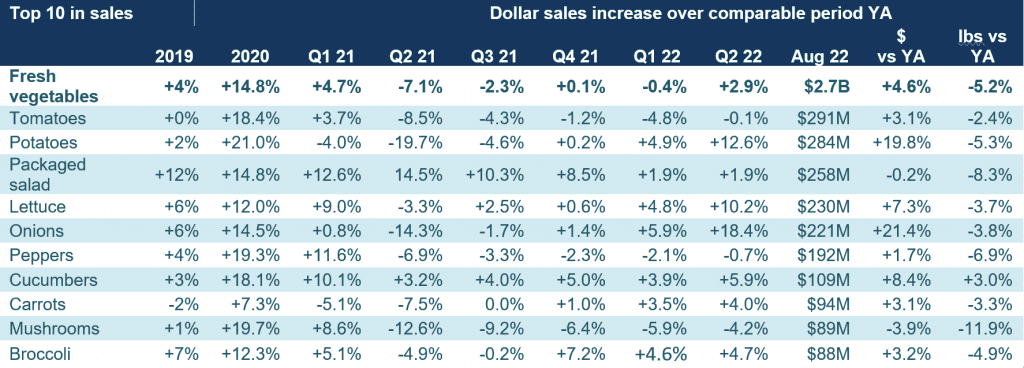The August Marketplace
Food inflation remains extremely high and consumers are feeling the pain. They are making changes to their restaurant engagement as well as their grocery purchases, according to the August IRI survey of primary grocery shoppers.
- 81% of American households bought at least one restaurant meal in August, with the highest restaurant penetration among Gen X, at 85%. This means that restaurant meals are not off the table, but consumers are more strategic about when they eat out versus order in as well as what they order.
- Takeout continues to be big, with 54% having ordered meals to go. Half of American households have eaten restaurant food on premise. Additionally, 20% have ordered from a restaurant for home delivery. “Home delivery is much more popular among Gen Z and younger Millennials, at 31%,” said Jonna Parker, Team Lead Fresh at IRI. “This is an important finding for grocery retailers. While this youngest shopper group may not represent a substantial share of total grocery spending today, their stake is growing. Gen Z and younger Millennials like restaurant delivery and they drive an above-average share of grocery e-commerce as well. Fresh fruit has a high level of impulse that retailers need to solve for in online orders. Additionally, ordering fresh produce online is not always as easy as ordering center-store items. In order for grocery to get its fair share of the total food delivery business, retailers need to focus on a seamless omni-channel experience.”
- When purchasing groceries, 85% of consumers shopped in person. Online shopping was near equally divided between click-and-collect (9%) and home delivery (6%). Delivery is more prevalent among Gen Z and younger Millennials, at 13%. Shoppers are not expecting a major change in their in-person versus online shopping: 4% expect they will buy all groceries online in the next few weeks and months, while 66% believe they will buy all groceries in person. The estimates among the remaining 30% range from expecting to buy some groceries online to most.
- Spending continues to be affected by out-of-stocks, with shoppers mentioning examples ranging from carbonated drinks to eggs, produce, milk and chicken. At the same time, when items are available for purchase, 42% stock up on staples out of concern for rising prices or the item being unavailable next time they shop. “Two-and-a-half years into the pandemic, the market has yet to re-establish a sustained balance,” said Joe Watson, VP, Retail, Foodservice & Wholesale for IFPA. “The out-of-stocks driven by labor, weather and supply chain challenges are exacerbated by consumers buying more than they need in the immediate term out of concerns for future availability and prices rising further. While fresh produce is certainly not isolated from the supply chain woes, we are holding our own and I am encouraged by the many innovative solutions and technologies retailers and others in the supply chain are employing to keep fresh produce flowing through the system.”
- 89% of consumers remain worried about the elevated gasoline prices and 94% are concerned about food inflation. They list examples from departments across the store as being significantly more expensive. The list is led by eggs, but includes meat, produce, milk, snacks, paper products and more. Eight in 10 shoppers (78%) are making changes to their shopping choices due to increased prices. The most popular money-saving measure is looking for sales/deals more often (50%), followed by cutting back on non-essentials (41%), looking for coupons and buying store-brand items more often (31%, each). “Despite the high gasoline prices, 15% switched some of their shopping to a lower-cost retailer and/or visit multiple stores to get the best deals,” Parker added. “This cherry-picking behavior may be driven by 53% of consumers reporting that fewer of the items they are looking for are on sale and 50% feel that items are not discounted as much as they used to be. We see these survey results also reflected in the grocery dollar channel shares. Traditional grocery has been losing share whereas value formats, including supercenters and club, have been gaining ground in fresh produce in recent months.”
“Inflation has been accelerating since early fall 2021, drought conditions are severe, consumer confidence is low and grocery patterns are switching very rapidly,” Watson noted. “Amid the continued disruption, IRI, 210 Analytics and IFPA remain committed to bringing the industry the latest trends and analysis in fresh produce.”
Inflation Insights
The price per unit across all foods and beverages in the IRI-measured multi-outlet stores, including supermarkets, club, mass, supercenter, drug and military, accelerated further to an increase of 14.3% in the four weeks ending August 28th, 2022 (“August”) versus year ago. This is up from +13.3% in July. August inflation was +16.6% in the center of the store (grocery) and +13.3% for perishables. Compared with August 2019, prices across all foods and beverages were up 27.4%.


Fresh produce prices were also up from last year, at +10.0% level on a per-unit basis and +10.6% on a per-pound basis. This is far below the total store average. While in the past few months fruit inflation was much lower than that of vegetables, price increases in August were very similar, at +10.8% for fruit and +10.4% for vegetables.

August 2022 Sales
The four August 2022 weeks brought $57.7 billion in total food and beverage sales, which was up +8.7% versus year ago. This was about the same year-on-year increase as seen in July. August 2022 dollar sales were up +25.7% versus August 2019 — the pre-pandemic normal. Perishables, including produce, seafood, meat, bakery and deli, had average dollar performance, but center-store item sales increased a little over 10%.
Year-on-year gains were inflation-boosted, with unit sales down -5.0%. Unit declines have averaged between -4% and -5% for several months now. Additionally, units dropped below 2019 levels for all areas of the store. Yet, prices having increased more than 27% versus 2019 and units down a mere -1.3% shows that consumer demand at retail remains strong.


August 2022 fresh produce sales reached $5.9 billion, surpassing the record set the prior year by +4.2%. However, looking beyond dollars that were highly affected by inflation, unit and volume declined versus August 2021 by more than 5%. Volume declines are steeper than unit declines, which may point to consumers moving to smaller pack sizes. The drought conditions may have an impact on these numbers as weather-induced discoloration, bruises or burns are impacting yields. In turn, this impacts in-store availability and price points on lower-quality items.


Fresh produce sales tapered off from $1.51 billion the first full week of August to $1.43 billion the fourth week ending August 28th. With it, the year-on-year growth rates fell from a high of +5.5% during the first week to +3.1% in the final August week. At the same time, volume declines worsened from being down -4.5% the week of August seventh to as much as -7.0% the third week of August. “August’s continued high and worsening food inflation has brought sharpened unit and volume declines,” Parker noted. “Volume declines had stayed well within 5% versus year ago,
but dipped far below that in August.”


“In the fourth quarter of 2021 and the first quarter of 2022, fruit grew much faster than vegetables,” explained Parker. “In July, fruit and vegetables came in at +4% dollar growth, each. In August, vegetable growth moved ahead of fruit once more.”


Fresh Produce Share of Total Fruits and Vegetables
“The fresh share of the business is one metric we watch closely at IFPA,” Watson commented. “The year-on-year growth in fresh produce (+4.2%) was far below the growth seen in shelf-stable and frozen fruits and vegetables in August. This could be one of the signs of consumers moving into recessionary spending, along with the strength in vegetables versus fruit, and sharpening volume and unit declines.”


The below-average growth for fresh produce meant a drop in the share of fresh fruit and vegetables versus the share represented by frozen (7.8%) and shelf-stable (10.6%). That said, at 81.6%, the fresh share of total produce remains ahead of 2021, demonstrating that shoppers are not walking away from fresh by any means.


Fresh Produce Dollars versus Volume
Fresh produce pound sales have trailed behind year ago levels since March 2021, but volume pressure sharpened in August. While in July pound sales were down -4.8% year-on-year, pounds were down -5.8% in August 2022 versus August 2021. Additionally, pounds dropped below the 2019 levels by nearly 1% in what has been a steady one to two-point decline each month from a high of +7% in the third quarter of 2021 (purple squares). Due to the high level of inflation, dollar sales do remain far ahead of the pre-pandemic normal (green triangles).


The overall produce volume pressure is driven by fruit. Fruit pounds were down -1.3% year-on-year in August, while vegetable volume sales were flat.


Fresh Fruit Sales in August
“The overall volume pressure in fruit is echoed by nearly all the big sellers,” Parker said. “Berries, that have been an incredible pandemic powerhouse, fell 5.6% behind year-ago levels. The deepest volume declines among the top 10 players were measured among mixed fruit and mandarins, but avocados and melons also backslid significantly.”


Fresh Vegetables Sales in August
“August’s vegetable performance was very mixed,” said Watson. “While most top sellers increased dollar sales, only cucumbers experienced an increase in volume. This is a stark illustration of the difficult marketplace.”


Fresh Produce Absolute Dollar Gains
In August 2022, fresh fruit added $119 million in sales and vegetables added $120 million when compared to August 2021. Gains were achieved in many different ways. Potatoes, onions, cherries, peaches and nectarines each had inflation of 20% or more compared with the average price per pound in August 2021. Berries, tomatoes and bananas had inflation well below the rate for total food and beverages and demand remained strong.


Perishables Performance
The smallest of the fresh departments, seafood, continues to experience substantial dollar and unit pressure in August 2022. While all areas experienced unit pressure, inflation helped increase dollars to achieve year-on-year gains, with the highest growth for refrigerated (including dairy, boosted by eggs) and bakery. Most areas have also fallen below 2019 levels in unit sales. Fresh produce is a notable exception. While produce is selling fewer pounds than in 2019 (-0.8%), units are up by 2.1% — once more pointing to a potential shift to smaller pack sizes.


What’s Next?
The BLS Consumer Price Index is pointing to some month-over-month moderation in areas other than food. However, year-on-year, prices continue to be significantly higher with little relief in sight. Supply chain and labor challenges also continue to challenge in-stock rates and retailers’ ability to promote. Unit and volume pressure has worsened across most department as consumers are pulling back on spending. But at the same time, it is not a universal race to the bottom, but rather a careful balancing act between opportunities to save versus occasions and items worth the splurge.
These patterns are likely to persist as inflationary pressure has accelerated since the fall of 2021. The August IRI survey found that:
- 32% of Americans are having difficulty affording needed groceries.
- Additionally, 43% of American households say their financial health is strained, nearly the same number as the 45% who say their financial situation is a lot or a little worse off than a year ago.
- The outlook for next year is mixed. While 30% believe their financial situation will be worse off, 28% believe they will be doing financially better.
The next report, covering September, will be released in mid-October. In addition to the data provided here, the IFPA also now offers InSite – an online interactive data set covering both produce and floral performance as well as a look at the 2021 consumer sentiment surveys. Start your free trial today! See www.freshproduce.com/insite for more detail. We also encourage you to contact Joe Watson, IFPA’s VP, Retail, Foodservice and Wholesale, at jwatson@freshproduce.com with any questions or concerns. Please recognize the continued dedication of the entire grocery and produce supply chains, from farm to retailer. #produce #joyoffresh #SupermarketSuperHeroes.
Date ranges:
2019: 52 weeks ending 12/28/2019
2020: 52 weeks ending 12/27/2020
Q1 2021: 13 weeks ending 3/28/2021
Q2 2021: 13 weeks ending 6/27/2021
Q3 2021: 13 weeks ending 9/26/2021
Q4 2021: 13 weeks ending 12/26/2021
Q1 2022: 13 weeks ending 3/27/2022
Q2 2022: 13 weeks ending 6/26/2022
August 2022: 4 weeks ending 8/28/2022



